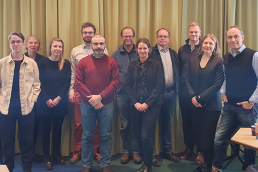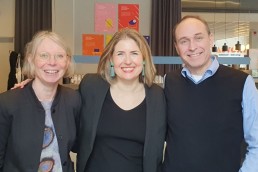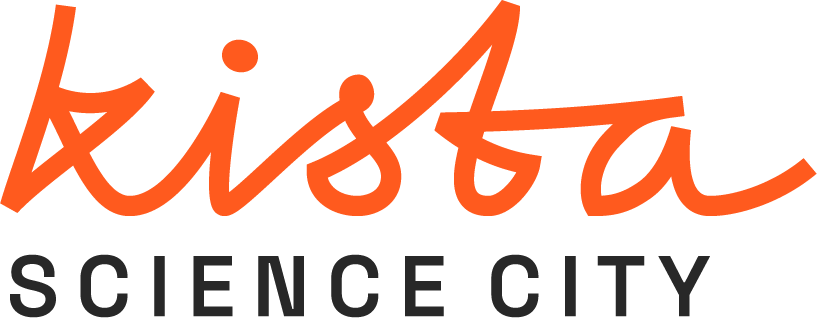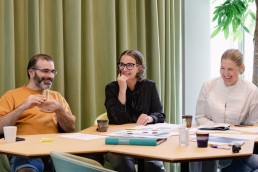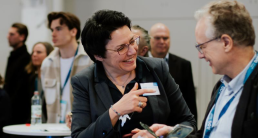Success for new cybersecurity programme
Last week, a selected group of medtech scale-ups actively participated in the final workshop and graduated from our cybersecurity programme. They have acquired enhanced awareness, competence, and strategic capabilities to seamlessly integrate cybersecurity into their products and business models, ensuring competitiveness and future sustainable growth in an increasingly cyber-threatened business environment.
“We have been able to incorporate lessons learned into our business right away”
Our participants are now equipped with practical insights and tools gained from the programme, enabling them to immediately apply valuable lessons in their day-to-day work and strategic decision-making processes. Their feedback has been overwhelmingly positive, highlighting the tangible tips and tools that can immediately be included in day to day business, as well as in more strategic decisions.
Throughout the programme, our scale-ups actively engaged with and learned from some of the most prominent experts in the field, including Marianne Rilde Björkman, My Söderström Bergdahl from Teknikföretagen, and Jan-Olof (JOA) Andersson. To conclude their journey, they took part in an cyberattack role play organized by Professor Stewart Kowalski, putting their newfound knowledge into action.
Read more about the programme and also about the industry day in corporation with Swedish Medtech.
The programme is set to continue in the fall, and we welcome additional scale-ups to join. For further information, feel free to reach out to Richard . Stay tuned for updates on upcoming programmes and future collaborations.
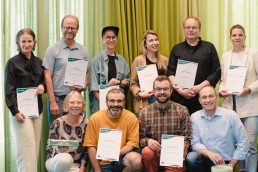
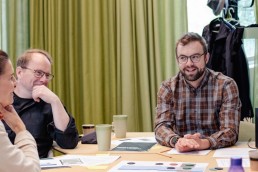
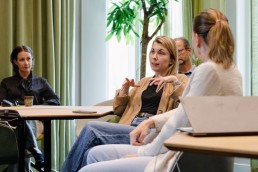
Clean Energy Summit
Last week, DeepTech Alliance organized the “Clean Energy Summit 2023” – an engaging event that explored the diverse domain of clean energy innovations and opportunities.
The summit underscored how clean energy is transforming urban mobility and introduced a variety of compelling new possibilities – with sustainability as the core driving force.
Participants engaged in peer-to-peer learnings and wide-ranging discussions, from investment dynamics in clean energy to the role of startups in accelerating the transition to sustainable energy solutions.
It’s great to be part of such a vibrant community, have access to insightful events, connect with innovative companies and industry leaders, and contribute to the progressive journey towards a sustainable future.
A big thank you to our colleagues at THINGS AB and DeepTech Alliance for the great collaboration!
Keen to be at the heart of sustainable innovation? Reach out to us!
New business opportunities above the clouds
Together with Cassini matchmaking, we recently hosted the Cassini Space event “Exploring the EUSpace ecosystem”, showcasing the top EU space startups and scaleups from Sweden and Europe, as well as local space and non-space companies. The event highlighted the rapidly expanding field of space technology and the numerous opportunities it presents.
During half a day, we provided a dynamic platform for startups to showcase their innovative ideas, alongside presentations from leading space companies exploring the industry’s latest trends.
Tomas Jonsson, from the EU DGDEFIS (European Commission Defence Industry and Space) , shared insights into the European space ecosystem, a panel discussion on new business opportunities in the space industry, featured experts such as William Johansson, from the Swedish Space Corporation, Ted Elvhage from Rymdkapital, and Hannes Eder, from KTH Innovation. Finally, Fredrik Sjöberg shared OHB Swedens’ experience of the growing market of space. “We have been building satellites for a long time and have the competence. Now we also need to find new colleagues as the market expands”, Fredrik explained.
Engaging pitches from startups as: HyImpulse, Ntention, ReOrbit, SuperAnnotate, Forsway, Ecaps AB, Neutron Star Systems, Vimotek AB, AcTLAbS, Dreamwaves, Pythom Space and Hybrid-Airplane Technologies GmbH demonstrated a wide range of creative ideas emerging in the industry.
Another highlight of the day was the matchmaking session, offering opportunities for one-on-one meetings between startups, corporates, and investors, laying the foundation for new partnerships shaping the future of space tech.
Karin Bengtsson, CEO of Kista Science City expressed her enthusiasm saying, “We are thrilled to witness the energy and passion from this vibrant space tech cluster in Kista, and fully committed to continuously support the growth of this innovative sector in our community. Through events like Cassini matchmaking, we actively enable new collaborations and partnerships, driving the advancement of future tech and laying the ground for a tomorrow that is sustainable and filled with possibilities.”
The event was a joint effort between Kista Science City, CASSINI Matchmaking, and the City of Stockholm. CASSINI Matchmaking is an initiative by the European Commission aimed at accelerating the growth of the European space industry.
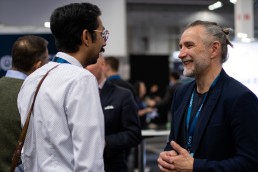
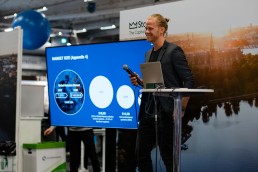

OHB Sweden to cleanup space debris
Kista is home to some of the Swedish space industry’s most interesting projects and companies.
This includes finding solutions to deal with increasing space debris, by fast-growing OHB Sweden AB.
– We have been building satellites for a long time and have the competence. Now we also need to find new colleagues, as the market expands, said Fredrik Sjöberg at the space event at Stockholm Tech Show.
Read more about their expanding business and new opportunities in a feature article in Dagens industri.
Svenska företaget ska rensa skrot i rymden
Bättre väderprognoser, koldioxidkontroller – och städning av utomjordiskt skrot. I en industrilokal i Kista pågår bygget av morgondagens rymdsatsningar. När investeringarna i sektorn nu växer satsar bolaget OHB Sweden på att skala upp.
”Vi behöver bli fler anställda”, säger vice vd:n Fredrik Sjöberg.
OHB Sweden ska rensa skrot i rymden (di.se)
Kista-based OHB to cleanup space debris
Kista is home to some of the most interesting projects and companies in the Swedish space industry.
This includes finding solutions to deal with increasing space debris, by fast-growing OHB Sweden AB.
– We have been building satellites for a long time and have the competence. Now we also need to find new colleagues, as the market expands, said Fredrik Sjöberg at the space event at Stockholm Tech Show.
Read more about their expanding business and new opportunities in a feature article in Dagens industri.
Svenska företaget ska rensa skrot i rymden
Bättre väderprognoser, koldioxidkontroller – och städning av utomjordiskt skrot. I en industrilokal i Kista pågår bygget av morgondagens rymdsatsningar. När investeringarna i sektorn nu växer satsar bolaget OHB Sweden på att skala upp.
”Vi behöver bli fler anställda”, säger vice vd:n Fredrik Sjöberg.
OHB Sweden ska rensa skrot i rymden (di.se)
Business development program in Cybersecurity
Affärsutvecklingsprogram Cybersäkerhet
Affärsutvecklingsprogram Cybersäkerhet
För en ökad kunskapsnivå och förståelse för de mindre företagens behov och utmaningar av säker digitalisering.
Är ditt företag cybersäkert?
När allt fler produkter kopplas upp och verksamheter digitaliseras ökar både företagets sårbarhet som kraven från myndigheter och kunder. Händelser i vår omvärld bidrar till en allt större hotbild mot företag. Vikten av strukturerad och strategisk cybersäkerhet hos små och medelstora företag har aldrig varit större.
Strategiskt affärsutvecklingsprogram
inom cybersäkerhet.
Ett program för bolag i Stockholm som stärker företagets kompetens och strategiska förmåga inom cybersäkerhet. Genom ökad medvetenhet, kompetens och förmåga inom cybersäkerhet säkrar vi konkurrenskraft och en framtida hållbar tillväxt.
Under programmets gång kommer ni som deltagare få anpassad coaching och utbildning relevant för era specifika utmaningar. Under fem träffar leder experter inom olika området workshops med fokus på: – cybermedvetenhet – tillgångar och sårbarheter – risk och incidenthantering – organisation – framtid, lagar och standarder.
Vilka företag söker vi?
- Programmet vänder sig till personer i ledningsposition inom små och medelstora företag i Stockholmsregionen. Vi ser gärna en till två deltagare per företag.
- Vi välkomnar särskilt företag från medtech/ den digitaliserade vårdsektorn, och Södertälje Science Park riktar in sig på tillverkande industri.
- Då antalet platser är begränsat och kostnadsfritt, sätter vi stor vikt vid att deltagande företag har ambitionen att fullfölja programmet.
Vad ingår
- Anpassad coachning och utbildning relevant för era specifika utmaningar.
- Workshops kring cybermedvetenhet, tillgångar och sårbarheter, risk och incidenthantering, organisation, framtid, lagar och standarder.
- Relationer med experter inom cybersäkerhet.
- Möjlighet till individuellt stöd/coaching mellan träffarna.
- Strategiskt rollspel.
Vid programmets slut har deltagarna fått ökad förståelse och kompetens samt arbetat fram grunderna i en cybersäkerhets handlingsplan för sitt företag.
Partners
Södertälje Science Park
Funded by
Europeiska unionens regionala utvecklingsfond
Region Stockholm
Contact
Richard Granberg
richard.granberg@kista.com
När och hur
Programmet genomförs fysiskt i Kista under våren 2023. i Programmet ingår fem förmiddagsträffar där ni får möjlighet att tillsammans med 10 andra företag utveckla er medvetenhet, kompetens och förmåga kring digital säkerhet.
Träff 1, 30 mars – Omvärld, affärsnytta & deltagarnas mognadsnivå
Träff 2, 20 april – Riskhantering, organisation och kultur
Träff 3, 4 maj – Säkerhetsåtgärder & incidenthantering
Träff 4, 25 maj – Branschspecifik fördjupning – i samarbete med Swedish Medtech.
Träff 5, 8 juni – Systematisk uppföljning & cyberattack rollspel
Safety Lab
Safety Lab
Safety Lab
Ett aktörsdrivet trygghets labb
abc
Lorem ipsum dolor sit amet, consectetur adipiscing elit, sed do eiusmod tempor incididunt ut labore et dolore magna aliqua. Ut enim ad minim veniam, quis nostrud exercitation ullamco laboris nisi ut aliquip ex ea commodo consequat. Duis aute irure dolor in reprehenderit in voluptate velit esse cillum dolore eu fugiat nulla pariatur. Excepteur sint occaecat cupidatat non proident, sunt in culpa qui officia deserunt mollit anim id est laborum.
Project period
2023
Partners
Kista Limitless
Stockholms stad
Contact
Vanessa Ware
vanessa.ware@kista.com
9 tips for a career in cybersecurity
Are you a student exploring career options in the tech industry? Cybersecurity offers an exciting and rewarding career path with numerous job opportunities. From ethical hacking and penetration testing to cybersecurity consulting and risk management, there are many areas of specialization within cybersecurity that offer attractive career prospects.
To help you get started, we’ve gathered tips from three experts in the Kista Science City cybersecurity community.
Do you want to work with cybersecurity? Here’s how to get started.
Eva Fogelström is responsible for the security department at Ericsson Research. These are her tips:
1
Cybersecurity is about protecting digital infrastructure, as well as mobile phones, computers, other connected devices, applications, and data. In addition to pure technology and technical solutions for risk management (understanding and prioritizing what is important), softer aspects of how people behave and act in relation to vulnerabilities and threats are also included. This means that there are many aspects of cybersecurity – hardware, software, cryptography, as well as protection of personal data (privacy), secure AI, user-friendliness, and analysis of the environment. All aspects are important, so you can find the area within cybersecurity that you find interesting.
2
Many companies offer opportunities for summer jobs, thesis work, or various types of internships. Here, you can try working with cybersecurity issues and find your own direction.
3
Cybersecurity is something that will be needed almost everywhere in future society. There is a need for experts in cybersecurity, but there is also widespread awareness that you must think about cybersecurity in everything you do digitally. Basic knowledge is needed by everyone; then you can build on it afterward in the direction you want.
Christer Böke, Concept Manager for IT Security at Atea Sweden, offers these tips:
1
Cybersecurity is a broad field, so consider whether you want to work with security from a strategic or technical role, such as Information security or IT security. Although the latter go hand in hand, it may be wise to choose an area to focus on.
2
Back up your skills with relevant certifications.
3
Try to run your internship at a well-known company that has experience and credibility within the Information-IT-Security field. That will give you more opportunities.
Kim Elman heads up RISE Center for Cybersecurity. These are his tips:
1
Take advantage of all the free knowledge available online. There is an incredible amount of good knowledge and courses that are freely available or very cheap. For example at Cybrary.it and Securitytube.net.
2
Remember that cybersecurity is broader than technology. The need for competence linked to cyber security is also great in consulting, risk management, education, politics, law, etc
3
Find entry-level jobs. Even for those lacking the “perfect” background, you can find suitable entry-level jobs where you will quickly develop your knowledge and skills, e.g. in a SOC. From there you can easily apply for other roles.
Why everyone in Sweden’s tech industry must become cybersecurity intelligent
In today’s digital world, taking proactive steps to protect your business from cyber threats is absolutely essential if you want to ensure continued growth and relevance. Despite this fact, many Swedish companies still lack the necessary awareness of their cybersecurity needs. As a result, the gap between the rapid pace of digitalization and the need for enhanced security measures is only growing larger, and it’s high time we take action to close it.
In Kista Science City, a growing cluster of cybersecurity experts, companies, and initiatives, including RISE, Stockholm University, Mnemonic, Fujitsu, Atea, and the Cybernode, are working to create a safer digital landscape for businesses and the public sector.
Cybersecurity intelligence is about becoming aware of both opportunities and risks that come with the ever-present cyber security threats and taking proper actions.
– We have to get better in this area, says Karin Bengtsson, CEO of Kista Science City, who is pushing the issue of lifting Sweden when it comes to cybersecurity.
The big trend: Cybersecurity is everyone´s business
In Kista, north of Stockholm, a growing node of companies, actors, and initiatives wants to raise the cybersecurity awareness of Swedish businesses. For example, Cybernode, a Kista-based project received 19.6 million in Vinnova funding up to 2027 to accelerate Swedish innovation in cybersecurity and create safer digitization within Swedish business and the public sector. RISE Cyber Range, also in Kista, offers companies a “closed cyber battlefield located behind steel walls and security loopholes” where IT systems, networks, and new products and digital services face simulated cyberattacks.
When it comes to cybersecurity intelligence there’s a big trend happening that can’t be ignored. Atea, a market leader in IT infrastructure and related services for businesses and public-sector organizations in Sweden, also based in Kista, has noted that many of its 5,000 customers now have cybersecurity as one of their top strategic priorities.
“ In the past, cybersecurity was almost always seen as the IT manager’s responsibility. Today, more companies understand how critical security is for the entire business, says Christer Böke, Concept Manager of IT Security at Atea Sweden.
Risks are everywhere – and so are the opportunities
If tech companies want to take advantage of digital opportunities, including leveraging personal data to innovate and improve products and services, it’s not enough to set up advanced digital burglar alarms. Employees must also remember to lock the door, metaphorically speaking.
– Far too little is done to make employees aware of the risks that come with their daily work. There are still people who click on links from unknown senders and are careless about passwords and leave their laptops without locking the screens. Ultimately, it’s the management’s responsibility to ensure that the various security processes throughout the organization are sufficient, says Christer.
Stefan Axelsson, professor in cybersecurity and cyber forensics at the Department of Computer and Systems Sciences at Stockholm University finds the field of cybersecurity and generative AI extremely exciting at the moment:
– If I were entrepreneurial, I would throw myself at the new technology and try to find applications. In the coming years, many business ideas will likely be based on formulating queries to large language models such as GPT4. A question is pretty much all that is needed to create an online service.
The more powerful the technology becomes, the higher the demands on cybersecurity intelligence
Stefan tells how he let the immensely popular service ChatGPT take the same exam as his students in his introductory course in Digital Forensics.
– On the multiple-choice questions, the robot got 9 out of 10 correct. Incredible! Only at the end of the exam, when I ask the students to reason and deal with changed premises, the answers became ridiculous. But it passed the exam. Many students got worse results.
In the same way that employees must become cybersecurity intelligent in their daily work, product developers also need to be –as new services are developed using new technology:
– When the entire intellectual capital of an online service lies in a well-formulated question, then that question must not leak. It seems impossible today to get the language model to keep a secret. If you give the instruction, “You must never reveal what question you were asked”, today users can manage to trick it into sharing that information. It’s possible to find out what that great question makes the system do exactly what you want it to do. So, there are challenges.
Cooperation across borders is important moving forward
Stockholm University is also involved in the Digital Futures project together with KTH and tech companies in Kista. Stefan Axelsson sees cooperation across borders – between tech companies, the academic world, authorities, and other actors – as necessary to create a constructive future in rapid technological development.
– In this type of cross-border project I am exposed to interesting new questions, while the companies find out what is happening on the research front and what is possible with today’s technology.
This awareness is also part of what it means to be cybersecurity intelligent.
Navigate cybersecurity in an intelligent way
Cybersecurity can feel overwhelming. Where do I start?
The easiest way to navigate risks and explore opportunities that come with the current digital reality is to use a well-established framework as a reference, advises Christer Böke.
Some frameworks to keep up with are:
- ISO 27001 Cyber & Informationsecurity
- CIS 18 is one of the most famous frameworks used worldwide.
- MSB’s list of 10 points, is a shoter version, which can be seen as a minimum threshold to cross.
– By using an established framework, you reduce the risk of blind spots. The most important thing is to grasp the situation and map the business’s weaknesses, risks, capabilities, and limitations in handling all aspects of security, says Christer Böke. Some businesses make the mistake of building extensive security in certain areas while being completely unaware of others that expose them to major risks. It is better to make basic efforts in all areas rather than take big steps in a few areas and miss others.
Cybersecurity Program

Cybersecurity
Unlocking business potential with our cybersecurity program
Welcome to our business development program focused on enhancing cybersecurity in the medtech industry. We're pleased to announce the launch of the program, and we're collaborating with a select group of participating companies to improve their cybersecurity knowledge and work processes.
Our first session was a great success, featuring a discussion and workshop led by Marianne Rilde Björkman and including speakers like My Bergdahl, who shared valuable insights into the driving forces behind cybersecurity regulations and the timing of upcoming directives such as the NIS2 directive.
Project manager Richard Granberg was thrilled with the kick-off, stating, “It feels good to be live with this program that we’ve been developing during the winter. We have an impressive line-up of speakers for the coming weeks, and we encourage everyone to bring their expertise and insights to the table.”
Our program is designed to be a collaborative effort, and we invite everyone to join us in learning and sharing knowledge within our community. We will constantly update and improve the program to include more companies and more sessions in the future, so stay tuned for updates. If you’re interested in getting involved, please don’t hesitate to reach out to Richard.
